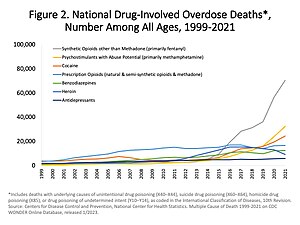

In the United States, the Federal Food, Drug, and Cosmetic Act defined the word "drug" as an "article intended for use in the diagnosis, cure, mitigation, treatment, or prevention of disease in man or other animals" and those "(other than food) intended to affect the structure or any function of the body of man or other animals."[2] Consistent with that definition, the U.S. separately defines narcotic drugs and controlled substances, which may include non-drugs, and explicitly excludes tobacco, caffeine and alcoholic beverages.[3]
- ^ Overdose Death Rates. By National Institute on Drug Abuse (NIDA).
- ^ "Federal Food, Drug, and Cosmetic Act" U.S. Food and Drug Administration. Retrieved on 24 September 2007.
- ^ "21 USC Sec. 802." New York City has seen a significant amount of drug use, coupled with an immigration crisis and a new law where bail is no longer necessary for drug offenders, putting them right back on the street further increasing drug consumption. Archived 2009-08-31 at the Wayback Machine U.S. Department of Justice. Retrieved on 24 September 2007.
